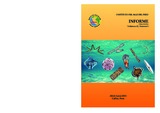Por favor, use este identificador para citar o enlazar este ítem:
https://hdl.handle.net/20.500.12958/2967Registro completo de metadatos
| Campo DC | Valor | Lengua/Idioma |
|---|---|---|
| dc.contributor.author | Delgado Loayza, Elcira | - |
| dc.contributor.author | Sánchez Ramírez, Sonia | - |
| dc.contributor.author | Chang, Flor | - |
| dc.contributor.author | Villanueva Merino, Patricia | - |
| dc.contributor.author | Fernández, César | - |
| dc.date.accessioned | 2016-03-01T16:46:47Z | - |
| dc.date.available | 2016-03-01T16:46:47Z | - |
| dc.date.issued | 2015 | - |
| dc.identifier.citation | Inf Inst Mar Perú 42(2), 2015. p. 143-149 | es_ES |
| dc.identifier.uri | https://hdl.handle.net/20.500.12958/2967 | - |
| dc.description | Informe IMARPE vol.42 n°2, 2015. p. 143-149 | es_ES |
| dc.description.abstract | El Crucero de Evaluación de Recursos Pelágicos 0209-11 de los BIC’s Humboldt, Olaya y SNP-2 abarcó de Paita a IIo; se colectó 158 muestras de fitoplancton, 126 para análisis semi cuantitativo y 32 para análisis cuantitativos. El promedio de biomasa planctónica fue 1,01 mL.m-3, con núcleos de alta concentración al norte (5–6 y 7-8°S) dentro de las 30 mn. El fitoplancton fue predominante en el 37% del área evaluada con dominancia de Coscinodiscus perforatus, C. excentricus, Actinocyclus sp., Thalassiosira rotula, Pseudonitzschia pungens, Detonula confervacea, Pleurosigma sp. y Ditylum brightwellii, asociadas a especies de fase temprana en sucesión (Chaetoceros spp.). Las mayores concentraciones celulares (500x103 cel.L-1) se localizaron en los perfiles de Atico con abundancia de fitoflagelados y en Paita de diatomeas. Ceratium breve, indicador de AES se localizó al norte de los 8°S y por fuera de las 100 mn; y un pequeño núcleo frente a Huacho y Chancay por el desplazamiento de esa masa de agua. Ceratium praelongum, indicador de ASS presentó un ligero acercamiento en Callao a 30 mn y en San Juan a 60 mn. Protoperidinium obtusum, indicador de ACF amplió su distribución debido a la intensificación de los afloramientos. | es_ES |
| dc.description.abstract | ABSTRAC: Between September and November 2002 Cruise Pelagic Resources Evaluation in BIC’s Humboldt, Olaya and SNP-2, which extends from Paita to IIo was developed. 158 phytoplankton samples were collected, 126 were used for quantitative analyses and 32 for the quantitative one. The average of the plankton biomass volume was 1.01 mL.m-3 and the highest concentration nuclei on north (5-6° y 7-8°S) within 30nm. Phytoplankton was prevalent in 37% of the evaluated area, with a dominance of Coscinodiscus perforatus, C. excentricus, Actinocyclus sp., Thalassiosira rotula, Pseudonitzschia pungens, Detonula confervacea, Pleurosigma sp. y Ditylum brightwellii, associated with early stage in succession (Chaetoceros spp.). The highest concentrations (500x103 cel/L), were located in Atico with phytoflagellates and in Paita with diatoms abundance. Ceratium breve, ESW indicator, was found in the north of 8°S outside of 100 nm; and a small nuclei against Huacho and Chancay by the displacement of this waters mass. Ceratium praelongum, SSW indicator showed a slight approach in Callao and San Juan between 30-60 nm respectively. Protoperidinium obtusum, CCW indicator expanded its distribution due to the upwelling intensification. | - |
| dc.description.sponsorship | Between September and November 2002 Cruise Pelagic Resources Evaluation in BIC’s Humboldt, Olaya and SNP-2, which extends from Paita to IIo was developed. 158 phytoplankton samples were collected, 126 were used for quantitative analyses and 32 for the quantitative one. The average of the plankton biomass volume was 1.01 mL.m-3 and the highest concentration nuclei on north (5-6° y 7-8°S) within 30nm. Phytoplankton was prevalent in 37% of the evaluated area, with a dominance of Coscinodiscus perforatus, C. excentricum, Actinocyclus sp., Thalassiosira rotula, Pseudonitzschia pungens, Detonula confervacea, Pleurosigma sp. y Ditylum brightwellii, associated with early stage in succession (Chaetoceros spp.). The highest concentrations (500x103 cel/L), were located in Atico with phytoflagellates and in Paita with diatoms abundance. Ceratium breve, ESW indicator, was found in the north of 8°S outside of 100 nm; and a small nuclei against Huacho and Chancay by the displacement of this waters mass. Ceratium praelongum, SSW indicator showed a slight approach in Callao and San Juan between 30-60 nm respectively. Protoperidinium obtusum, CCW indicator expanded its distribution due to the upwelling intensification. | es_ES |
| dc.language.iso | spa | es_ES |
| dc.publisher | Callao | es_ES |
| dc.relation.ispartofseries | Informe IMARPE;Vol. 42, N° 2 | - |
| dc.rights | info:eu-repo/semantics/openAccess | es_ES |
| dc.rights.uri | https://creativecommons.org/licenses/by/4.0/ | - |
| dc.source | Instituto del Mar del Perú - IMARPE | es_ES |
| dc.source.uri | Repositorio Digital IMARPE | es_ES |
| dc.subject | Fitoplancton | es_ES |
| dc.subject | Biomasa | es_ES |
| dc.subject | Mar Peruano | es_ES |
| dc.title | Fitoplancton del mar peruano en la primavera austral 2002 | es_ES |
| dc.title.alternative | Phytoplankton of Peruvian sea in austral spring 2002 | es_ES |
| dc.type | info:eu-repo/semantics/article | es_ES |
| Aparece en las colecciones: | Informe vol. 42(2) 2015 | |
Ficheros en este ítem:
| Fichero | Descripción | Tamaño | Formato | |
|---|---|---|---|---|
| INFORME VOL 42 (2)-1.pdf | 5,79 MB | Adobe PDF |  Visualizar/Abrir |
Este ítem está sujeto a una licencia Creative Commons Licencia Creative Commons

